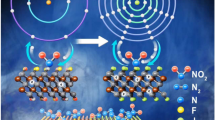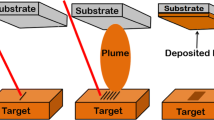Abstract
In this study, thin films of poly(cyclohexyl methacrylate) (PCHMA) were deposited on silicon wafer using PECVD technique, in which the plasma power is inductively coupled through a quartz window using a planar-coil antenna, which was placed outside of the vacuum chamber. PCHMA is a desired sacrificial polymer for many applications because of its hydrophobicity and clean decomposition properties upon thermal annealing. During PECVD of PCHMA, the effects of plasma power and substrate temperature on the deposition rates and structural properties of as-deposited films were investigated. The highest deposition rate (46.5 nm/min) was observed at a low substrate temperature (15 °C) and at a high applied plasma power (30 W). FTIR and XPS analyses of the deposited films confirmed that the percentage of retained functional groups was increased if the intensity of applied plasma power was lowered. As-deposited PCHMA was found to decompose cleanly upon thermal annealing. The onset of thermal decomposition was 89 °C for the film deposited at 5 W applied plasma power.






Similar content being viewed by others
References
Orr CA, Cernohous JJ, Guegan P, Hirao A, Keon HK, Mocosko CW (2001) Homogeneous reactive coupling of terminally functional polymers. Polymer 42(19):8171–8178. https://doi.org/10.1016/s0032-3861(01)00329-9
Frechet JM (1994) Functional polymers and dendrimers: reactivity, molecular architecture, and interfacial energy. Science 263(5154):1710–1715. https://doi.org/10.1126/science.8134834
Kenley RA, Manser GE (1985) Degradable polymers. Incorporating a difunctional azo compound into a polymer network to produce thermally degradable polyurethanes. Macromolecules 18:127–131. https://doi.org/10.1021/ma00144a002
Kim SH, Yoon J, Yun SO, Hwang Y, Jang HS, Ko HC (2013) Ultrathin sticker-type ZnO thin film transistors formed by transfer printing via topological confinement of water-soluble sacrificial polymer in dimple structure. Adv Func Mater 23(11):1375–1382. https://doi.org/10.1002/adfm.201202409
Ferrell N, Woodard J, Hansford DJBM (2007) Fabrication of polymer microstructures for MEMS: sacrificial layer micromolding and patterned substrate micromolding. Biomed Microdev 9(6):815–821. https://doi.org/10.1007/s10544-007-9094-y
Joshi M, Kale N, Lal R, Ramgopal Rao V, Mukherji S (2007) A novel dry method for surface modification of SU-8 for immobilization of biomolecules in Bio-MEMS. Biosens Bioelectron 22(11):2429–2435. https://doi.org/10.1016/j.bios.2006.08.045
Martin H, Edgar V (2002) Bulk silicon micromachining for MEMS in optical communication systems. J Micromech Microeng 12(4):349. https://doi.org/10.1088/0960-1317/12/4/301
Casserly TB, Gleason KK (2006) Effect of substrate temperature on the plasma polymerization of poly(methyl methacrylate). Chem Vap Deposition 12(1):59–66. https://doi.org/10.1002/cvde.200506409
Lv A, Cui Y, Du F-S, Li Z-C (2016) Thermally degradable polyesters with tunable degradation temperatures via postpolymerization modification and intramolecular cyclization. Macromolecules 49(22):8449–8458. https://doi.org/10.1021/acs.macromol.6b01325
Hollie AR, Celesta EW, Vikram R, Sue Ann Bidstrup A, Clifford LH, Paul AK (2001) Fabrication of microchannels using polycarbonates as sacrificial materials. J Micromech Microeng 11(6):733. https://doi.org/10.1088/0960-1317/11/6/317
Metz S, Jiguet S, Bertsch A, Renaud P (2004) Polyimide and SU-8 microfluidic devices manufactured by heat-depolymerizable sacrificial material technique. Lab Chip 4(2):114–120. https://doi.org/10.1039/B310866J
Kelvin Chan KKG (2006) Air-gap fabrication using a sacrificial polymeric thin film synthesized via initiated chemical vapor deposition. J Electrochem Soc 153(4):C223–C228. https://doi.org/10.1149/1.2168297
Boucinha M, Chu V, Conde JP (1998) Air-gap amorphous silicon thin film transistors. Appl Phys Lett 73(4):502–504. https://doi.org/10.1063/1.121914
Kohl PA, Zhao Q, Patel K, Schmidt D, Bidstrup-Allen SA, Shick R, Jayaraman S (1998) Air-gaps for electrical interconnections. Electrochem Solid-State Lett 1(1):49–51. https://doi.org/10.1149/1.1390631
Jayachandran JP, Reed HA, Hongshi Z, Rhodes LF, Henderson CL, Allen SAB, Kohl PA (2003) Air-channel fabrication for microelectromechanical systems via sacrificial photosensitive polycarbonates. J Microelectromech Syst 12(2):147–159. https://doi.org/10.1109/JMEMS.2003.809963
Long Hua Lee KKG (2008) Cross-linked organic sacrificial material for air gap formation by initiated chemical vapor deposition. J Electrochem Soc 155(4):G78–G86. https://doi.org/10.1149/1.2837838
Ozaydin-Ince G, Gleason KK (2010) Thermal stability of acrylic/methacrylic sacrificial copolymers fabricated by initiated chemical vapor deposition. J Electrochem Soc 157(1):D41–D45. https://doi.org/10.1149/1.3251308
Tarducci C, Schofield WCE, Badyal JPS, Brewer SA, Willis C (2002) Monomolecular functionalization of pulsed plasma deposited poly(2-hydroxyethyl methacrylate) surfaces. Chem Mater 14(6):2541–2545. https://doi.org/10.1021/cm010939z
Alf ME, Asatekin A, Barr MC, Baxamusa SH, Chelawat H, Ozaydin-Ince G, Petruczok CD, Sreenivasan R, Tenhaeff WE, Trujillo NJ, Vaddiraju S, Xu J, Gleason KK (2010) Chemical vapor deposition of conformal, functional, and responsive polymer films. Adv Mater 22(18):1993–2027. https://doi.org/10.1002/adma.200902765
Clark DT, Abu-Shbak MM (1983) Plasma polymerization. IX. A systematic investigation of materials synthesized in inductively coupled plasmas excited in perfluoropyridine. J Polym Sci: Polym Chem Ed 21(10):2907–2919. https://doi.org/10.1002/pol.1983.170211006
Han LM, Timmons RB, Lee WW (2000) Pulsed plasma polymerization of an aromatic perfluorocarbon monomer: formation of low dielectric constant, high thermal stability films. J Vac Sci Technol B: Microelectron Nanometer Struct Process Measur Phenomena 18(2):799–804. https://doi.org/10.1116/1.591279
Gürsoy M, Uçar T, Tosun Z, Karaman M (2016) Initiation of 2-hydroxyethyl methacrylate polymerization by tert-butyl peroxide in a planar PECVD system. Plasma Process Polym 13(4):438–446. https://doi.org/10.1002/ppap.201500091
Manring LE (1988) Thermal degradation of saturated poly(methyl methacrylate). Macromolecules 21(2):528–530. https://doi.org/10.1021/ma00180a046
Malhotra SL, Minh L, Blanchard LP (1983) Thermal decomposition and glass transition temperature of poly(phenyl methacrylate) and poly(cyclohexyl methacrylate). J Macromol Sci: Part A Chem 19(7):967–986. https://doi.org/10.1080/00222338308081078
O’Shaughnessy WS, Baxamusa S, Gleason KK (2007) Additively patterned polymer thin films by photo-initiated chemical vapor deposition (piCVD). Chem Mater 19(24):5836–5838. https://doi.org/10.1021/cm071381j
Karaman M, Çabuk N (2012) Initiated chemical vapor deposition of pH responsive poly(2-diisopropylamino)ethyl methacrylate thin films. Thin Solid Films 520(21):6484–6488. https://doi.org/10.1016/j.tsf.2012.06.083
Pierson HO (1999) Fundamentals of chemical vapor deposition. In: Pierson HO (ed) Handbook of chemical vapor deposition (CVD), 2nd edn. William Andrew Publishing, Norwich, pp 36–67. https://doi.org/10.1016/b978-081551432-9.50005-x
Hegemann D, Körner E, Guimond S (2009) Plasma polymerization of acrylic acid revisited. Plasma Process Polym 6(4):246–254. https://doi.org/10.1002/ppap.200800089
Hegemann D, Hossain MM, Körner E, Balazs DJ (2007) Macroscopic description of plasma polymerization. Plasma Process Polym 4(3):229–238. https://doi.org/10.1002/ppap.200600169
Yasuda H, Hirotsu T (1978) Critical evaluation of conditions of plasma polymerization. J Polym Sci: Polym Chem Ed 16(4):743–759. https://doi.org/10.1002/pol.1978.170160403
Scheltjens G, Da Ponte G, Paulussen S, De Graeve I, Terryn H, Reniers F, Van Assche G, Van Mele B (2015) Thermal properties of plasma deposited methyl methacrylate films in an atmospheric DBD reactor. Plasma Process Polym 12(3):260–270. https://doi.org/10.1002/ppap.201400143
Beamson G, Briggs D (1993) High resolution xps of organic polymers: the scienta ESCA300 database. J Chem Educ 70(1):A25. https://doi.org/10.1021/ed070pa25.5
Cho SH, Park ZT, Kim JG, Boo JH (2003) Physical and optical properties of plasma polymerized thin films deposited by PECVD method. Surf Coat Technol 174–175:1111–1115. https://doi.org/10.1016/S0257-8972(03)00596-6
Matsumoto A, Mizuta K, Otsu T (1993) Synthesis and thermal properties of poly(cycloalkyl methacrylate)s bearing bridged- and fused-ring structures. J Polym Sci, Part A: Polym Chem 31(10):2531–2539. https://doi.org/10.1002/pola.1993.080311014
Ito H, Ueda M (1988) Thermolysis and photochemical acidolysis of selected polymethacrylates. Macromolecules 21(5):1475–1482. https://doi.org/10.1021/ma00183a043
DePuy CH, King RW (1960) Pyrolytic cis eliminations. Chem Rev 60(5):431–457. https://doi.org/10.1021/cr60207a001
Scheltjens G, Da Ponte G, Paulussen S, De Graeve I, Terryn H, Reniers F, Van Assche G, Van Mele B (2016) Deposition kinetics and thermal properties of atmospheric plasma deposited methacrylate-like films. Plasma Process Polym 13(5):521–533. https://doi.org/10.1002/ppap.201500137
Biederman H, Slavı́nská D (2000) Plasma polymer films and their future prospects. Surf Coat Technol 125(1):371–376. https://doi.org/10.1016/S0257-8972(99)00578-2
Holländer A, Thome J (2004) Degradation and stability of plasma polymers. In: Plasma Polymer Films. Imperial College Press And Distributed By World Scientific Publishing Co., pp 247–277. https://doi.org/10.1142/9781860945380_0007
Acknowledgements
This project was supported by the Scientific and Technological Research Council of Turkey (TÜBİTAK) with a Grant Number of 213M399.
Author information
Authors and Affiliations
Corresponding author
Additional information
Publisher's Note
Springer Nature remains neutral with regard to jurisdictional claims in published maps and institutional affiliations.
Rights and permissions
About this article
Cite this article
Yartaşı, Y., Karaman, M. Plasma Enhanced Chemical Vapor Deposition of Poly(Cyclohexyl Methacrylate) as a Sacrificial Thin Film. Plasma Chem Plasma Process 40, 357–369 (2020). https://doi.org/10.1007/s11090-019-10038-1
Received:
Accepted:
Published:
Issue Date:
DOI: https://doi.org/10.1007/s11090-019-10038-1




